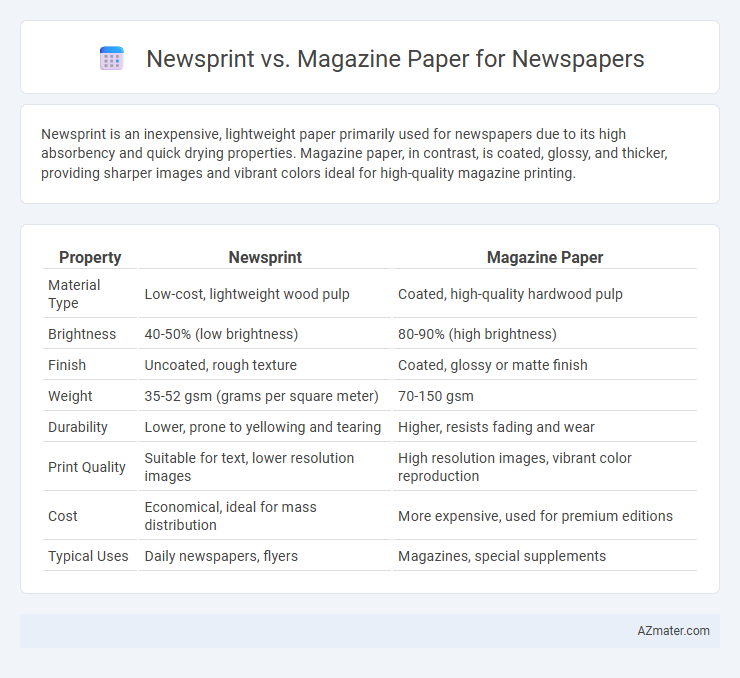Newsprint is an inexpensive, lightweight paper primarily used for newspapers due to its high absorbency and quick drying properties. Magazine paper, in contrast, is coated, glossy, and thicker, providing sharper images and vibrant colors ideal for high-quality magazine printing.
Table of Comparison
| Property | Newsprint | Magazine Paper |
|---|---|---|
| Material Type | Low-cost, lightweight wood pulp | Coated, high-quality hardwood pulp |
| Brightness | 40-50% (low brightness) | 80-90% (high brightness) |
| Finish | Uncoated, rough texture | Coated, glossy or matte finish |
| Weight | 35-52 gsm (grams per square meter) | 70-150 gsm |
| Durability | Lower, prone to yellowing and tearing | Higher, resists fading and wear |
| Print Quality | Suitable for text, lower resolution images | High resolution images, vibrant color reproduction |
| Cost | Economical, ideal for mass distribution | More expensive, used for premium editions |
| Typical Uses | Daily newspapers, flyers | Magazines, special supplements |
Understanding Newsprint and Magazine Paper
Newsprint is a lightweight, low-cost paper primarily made from wood pulp, designed for high-speed printing presses and rapid ink absorption, making it ideal for daily newspapers. Magazine paper, often coated and glossier, contains higher-quality fibers and additives that enhance image sharpness and color vibrancy, suited for premium magazine spreads and advertisements. Understanding the difference involves recognizing newsprint's focus on affordability and mass distribution versus magazine paper's emphasis on durability and visual appeal.
Key Differences Between Newsprint and Magazine Paper
Newsprint is a low-cost, lightweight paper predominantly used for newspapers, characterized by its high absorbency, low brightness, and rough texture, which makes it suitable for fast-printing presses and short-term use. Magazine paper, also known as coated paper, features a smooth, glossy or matte finish with higher brightness and opacity, optimized for high-quality images and color printing in magazines and glossy publications. The key differences lie in their composition, weight, and finish--newsprint is generally uncoated and lower quality for economical production, while magazine paper uses coatings and additives for vivid visuals and durability.
Print Quality: Clarity and Color Reproduction
Newsprint offers moderate clarity and limited color reproduction, making it suitable for cost-effective, high-volume newspaper printing with basic image quality. Magazine paper, with its coated glossy surface, significantly enhances print quality by providing sharper text and vibrant, true-to-life color reproduction. The improved opacity and smoothness of magazine paper reduce ink bleed and improve visual appeal, elevating reader engagement through superior print clarity and color fidelity.
Durability and Feel: Texture and Thickness
Newsprint offers a lightweight, rough texture with lower thickness, making it less durable and prone to yellowing and tearing over time. Magazine paper features higher thickness and a smoother, glossy texture, providing enhanced durability and a premium feel that better resists wear and moisture. The choice between newsprint and magazine paper directly impacts the newspaper's longevity and tactile experience for readers.
Cost Comparison: Newsprint vs Magazine Paper
Newsprint is significantly more cost-effective than magazine paper, making it the preferred choice for high-volume newspaper printing. Magazine paper's higher quality, glossy finish, and heavier weight result in increased production expenses and longer press times. Publishers seeking budget-friendly options prioritize newsprint to optimize printing costs without compromising basic readability.
Suitability for Newspaper Content
Newsprint is highly suitable for newspaper content due to its lightweight, cost-effective nature and ability to absorb ink quickly, ensuring sharp text and images essential for daily news production. Magazine paper, often coated and glossier, is less ideal for newspapers because it can cause smudging and increases printing costs without providing significant benefits for typical news articles. The porous texture and lower brightness of newsprint enhance readability under various lighting conditions, making it the preferred choice for mass-distributed newspapers.
Environmental Impact and Sustainability
Newsprint, primarily made from recycled fibers and wood pulp, has a lower environmental impact due to its biodegradability and high recyclability rates, making it a sustainable choice for newspapers. Magazine paper, often coated with clay and chemical finishes, poses greater challenges for recycling and tends to have higher energy consumption and waste generation during production. Choosing newsprint over magazine paper significantly reduces carbon footprint and supports circular economy initiatives in the print industry.
Printing Speed and Production Process
Newsprint offers faster printing speeds due to its lightweight and porous fibers, allowing high-speed rotary presses to operate efficiently in large newspaper production. Magazine paper, being coated and heavier, requires slower press speeds to ensure image quality and ink drying, resulting in a more complex and time-consuming production process. Production lines using newsprint benefit from lower costs and quicker turnaround times, while magazine paper demands precise control over coating and finishing stages for glossy, high-resolution results.
Reader Experience and Visual Appeal
Newsprint offers a matte finish with high absorbency, allowing for quick ink drying but often resulting in faded colors and less sharp images, which can affect reader engagement negatively. Magazine paper provides a glossy or semi-gloss finish that enhances color vibrancy and image clarity, significantly improving visual appeal and reader experience. The choice between newsprint and magazine paper directly influences print quality, readability, and overall aesthetic impact in newspapers.
Choosing the Right Paper for Your Publication
Selecting newsprint or magazine paper for your newspaper hinges on factors like cost, print quality, and durability. Newsprint offers cost-effectiveness and faster print runs, ideal for high-volume, daily publications, while magazine paper provides superior brightness, sharper images, and a glossier finish, enhancing visual appeal for feature stories or weekly issues. Evaluating your publication's budget, target audience, and desired aesthetic ensures the optimal choice between affordable, functional newsprint and premium, polished magazine paper.

Infographic: Newsprint vs Magazine paper for Newspaper
 azmater.com
azmater.com